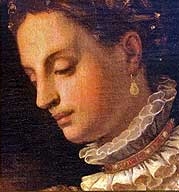 |
| Catherine de' Medici 1519-1589 |
 |
| A Barbie doll with the reproduction of the original wedding dress of Catherine de' Medici, created by the artisans of the city of Florence in 2008. |
Piegaro, Italy is a small town in the northwest of Umbria, historically considered as a borderland between Umbria and Tuscany. At one time Piegaro was called "The Little Paris". Piegaro has a lot in common with Tuscany, you might even hear people speak with a Florentine accent here.
Thinking of the important tradition that Tuscany has in its relationship with France, I may guess why something French might be considered as classy, sophisticated, and elegant and echoing here in Piegaro.
As a consequence, there must be historical reasons for this French influence and the first princely person we think of is the Florentine Catherine de' Medici, Queen of France.
Catherine belongs to the famous Medici family from Florence. In 1533 she got married to the king of France Henry II and she became Queen of France in 1547 at the age of 28. Catherine and Henry had ten children, among which several monarchs.
 |
| The classical scalloped dinner plate in the Ricco Deruta pattern (By Cama). |
 |
| A book about the art of needlework to learn the Renaissance original style of Catherine de' Medici. |
Catherine de' Medici was a grand patron of the arts in France according to her family tradition back in Italy and there is a long list of countless art activities that she accomplished at the French court, which made her unforgettable.
 |
| A close-up of the Barbie doll. The artisans first reproduced the original dress full size and made the miniature afterward. |
In Deruta many years ago there was a famous needlework laboratory owned by the Corcioni sisters.
Among their artwork, they listed the "Punto Madama Caterina" or "Punto Caterina de' Medici" which has been brought back to life in the past decade by the Cultural Association "Ars Umbra", located in Deruta, President Anna Lisa Piccioni.
Follow this link to admire a modern celebration of the Renaissance tradition of needlework in Umbria.
Follow this link to read about the latest exhibition about Caterina de' Medici in Florence, Palazzo Strozzi, 2009.
- Original Posts by Roberta Niccacci -
Follow this link to admire a modern celebration of the Renaissance tradition of needlework in Umbria.
Follow this link to read about the latest exhibition about Caterina de' Medici in Florence, Palazzo Strozzi, 2009.
-----------------------------------------
FRIENDS OF CAMA


